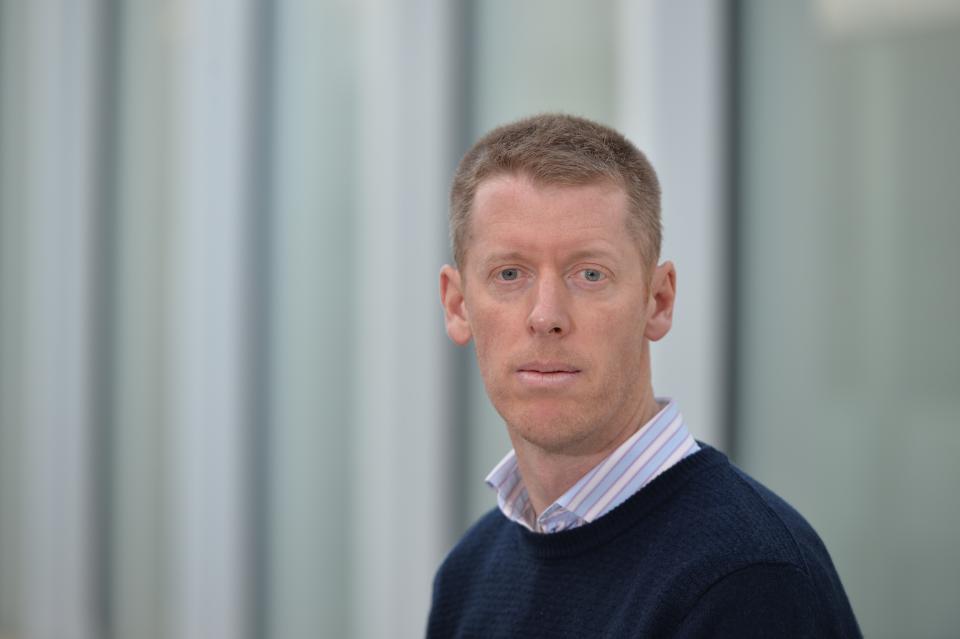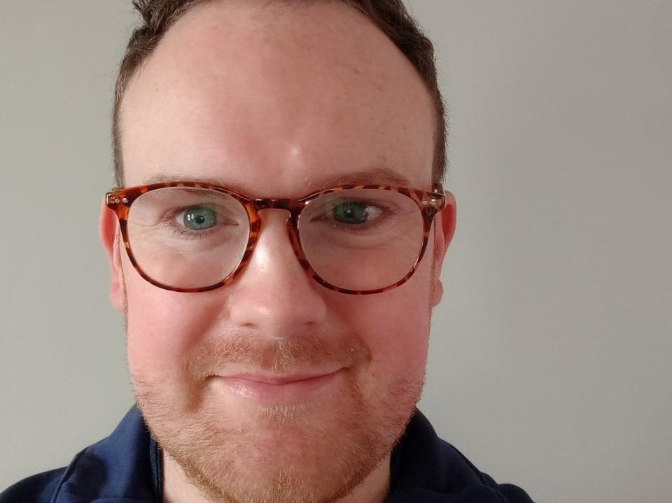
Ever since he was an undergraduate in biology, Dr. Simon Furney has always wanted to pursue a career in cancer research. “We learned so much about the biology of cells by studying what goes wrong in cancer. I think it was around then when I was very much drawn to this idea that by understanding the mechanisms of tumour development, we would have a much better chance of being able to treat cancer.”
For Dr. Furney, his interest in cancer research is also personal. “My Mum was diagnosed with breast cancer about 25 years ago and unfortunately, she passed away in 2008. So, that personal aspect is also there and is really important to me. I work across several cancer types in my research but whenever I have a project on breast cancer, it’s particularly poignant for me.”
Studies and career interest
His studies and career to date have taken him from Dublin to Manchester to Barcelona to London and back to Dublin again where he is Senior Lecturer in Physiology and Medical Physics at the Royal College of Surgeons Ireland (RCSI). This is where he also established the Genomic Oncology Research Group.
“My area of research is cancer genomics where we analyse the DNA from patients’ tumours to try to identify the genes which have led to tumour development. This is done using a technology known as genome sequencing,” explains Dr. Furney. The genome is the complete DNA sequence that makes up a human being and by sequencing the genome we can see which genes have been altered during tumour development.
The last 15 years has seen dramatic advances in genome sequencing technologies. “The first human genome sequence was finished only 20 years ago, and it took more than 10 years and hundreds of millions of dollars to complete. Today, human genomes can be sequenced in a matter of days and at a fraction of the cost, just a few hundred euro per genome.”
“Because of these advances, over the last decade tens to hundreds of thousands of cancer patients have had their tumours sequenced and this has led to a much greater level of understanding of what is happening to the genome during tumour development. In addition, we can use this sequencing technology to conduct RNA sequencing which tells us which genes have been expressed or turned on in a cell, and how this is changed in cancer.”
This is crucial, explains Dr. Furney, and has brought about the concept of personalised medicine for cancer patients. “No two tumours are identical at the genomic level, however, it is also really important to point out that some really important genes involved in cancer, known as driver genes, are frequently mutated, or changed, in cancer certain cancers.”
A good example of this is in breast cancer, says Dr. Furney, in which many patients have changes involving the oestrogen receptor or HER2 genes. “These are the main cancer drivers in these tumours and can be targeted with specific treatments. But personalised medicine is still very relevant here, as some patients will not have good responses to therapy or will have tumours that will eventually develop resistance to therapy.”
“No two tumours are identical at the genomic level, however, it is also really important to point out that some really important genes involved in cancer, known as driver genes, are frequently mutated, or changed, in cancer certain cancers” – Dr. Furney
Latest research project
This leads us to Dr. Furney’s latest research project, which analysed tumour genome data from breast cancer patients in Ireland to identify patterns and trends that may provide insight into which patients respond well to neoadjuvant (tumour-shrinking) therapy, and perhaps more importantly, which patients don’t respond well. “We know that up to 25% of all breast cancers are driven by the HER2 gene and are classified as HER2-positive (HER2+). Many of these patients are treated with neoadjuvant therapy targeted against HER2 in combination with chemotherapy, but around 30% of patients develop resistance to this treatment, and while the treatment isn’t working, their disease could eventually progress and get worse. Being able to identify these at-risk patients who won’t respond means you could get them onto a more tailored treatment after surgery,” explains Dr. Furney.
The study analysed blood and tissue samples from 22 patients participating in a clinical trial to try to find features to identify patients who won’t respond well to treatment, “We extracted DNA and RNA from the tumour samples and used sequencing technologies to sequence both the DNA and RNA in the tumours,” outlines Dr. Furney.
A statistical method to determine which combinations of the DNA sequencing data, RNA sequencing data and clinical features, might be predictive of patient response to the neoadjuvant therapy was then developed. “Using this approach, we identified a core set of features: patient age, oestrogen receptor status and level of immune cells, which together seem to be important for predicting patient response.”
“In addition, we were able to collect tumour samples before and after treatment for 5 patients, including metastatic samples from 3 patients who unfortunately had relapsed. This allowed us to study how the cancer changes during and after therapy, and the reason we conduct this is to detect potential therapy resistant tumour cells or ‘sub-clones’.”
“This couldn’t be pulled together without the support of our funders, so we are hugely appreciative of the BREAST-PREDICT funding made possible by the Irish Cancer Society” – Dr. Furney
Support of the Irish Cancer Society
Through its BREAST-PREDICT research funding, which funded a range of projects from 2013-2019, the Irish Cancer Society supported Dr. Furney, co-Senior author Prof. Bryan Hennessy and the multi-disciplinary team to conduct this project. “BREAST-PREDICT was instrumental in a number of ways,” says Dr. Furney. “First, it allowed us to access funding for sequencing when it was bit more expensive back then. As I mentioned earlier, sequencing has come a long way in the last two decades, but even going back a few years compared to now, it was much more expensive, and this funding enabled us to carry this out which was critical for the research.”
“Second, the funding also allowed us to implement this multi-disciplinary research collaboration and build upon the huge amount of work done by clinicians in designing and running the clinical trial. . It is crucial to acknowledge the broad range of people necessary to successfully conduct a project of this scale, which requires the patients first and foremost, research nurses and coordinators, surgeons, pathologists, oncologists, laboratory scientists, and finally bioinformaticians who conduct the data analysis. This couldn’t be pulled together without the support of our funders, so we are hugely appreciative of the BREAST-PREDICT funding made possible by the Irish Cancer Society.”
In terms of next steps for the research project, Dr. Furney says “this study provides the foundation to conduct larger and more comprehensive genomic studies involving patients in clinical trials in breast cancer and other cancer types in Ireland. We are hopeful that we will be able to build on and improve our approach moving forward. With respect to this, Cancer Trials Ireland opened a new HER2-positive breast cancer clinical trial, the Shamrock study, in September at several hospitals across the country.”
Future of cancer research
Looking ahead, Dr. Furney believes we are on the cusp of exciting new developments and advances in the cancer research space. “Over the next 20 years I would hope to see more integration and translation of genome sequencing for personalised cancer medicine. We are able to conduct these studies in a research setting, and I would hope that as genome sequencing becomes cheaper again and our ability to understand all these types of data improves, and that this will really translate into clinical cancer care.”
So, it’s only really when we try to put these different layers of information together, in combination with other data from imaging or pathology, that we can start to build towards integrating all of this into personalised cancer medicine. I would expect to see a lot of progress in doing this over the next 10-20 years.”
- You can read Predictive modelling of response to neoadjuvant therapy in HER2+ breast cancer here via npj breast cancer.
Blood Cancer Awareness Webinar: Dr Graeme Sullivan and Dr Daniel Angelov

September was Blood Cancer Awareness Month, we turned our focus to some of the research we are currently funding into multiple myeloma and non-Hodgkin’s lymphoma. This month, we hear from two of our Blood Cancer Researchers, Dr Daniel Angelov and Dr Graeme Sullivan, both of whom presented at our recent Blood Cancer Awareness Webinar.
Blood cancer is a group of cancers that include lymphoma, myeloma, leukaemia, and myelodysplastic syndromes. When blood cancer occurs, normal blood cell development is affected by the uncontrolled growth of the cancer cells. These cancerous cells stop your blood from performing the functions it’s supposed to do, like fighting infections or clotting your blood when you’re cut. Both Dr Graeme Sullivan and Dr Daniel Angelov research treatment resistance.
Dr Graeme Sullivan
After qualifying as a dentist and entering clinical practice 15 years ago, Dr Graeme Sullivan felt the research world was calling out and so embarked upon his PhD studies in the area of molecular biology. Spurred on by his experience working with patients and carrying out scientific ‘at the bench’ research, this resulted in him co-developing a recently patented therapy for psoriasis, before moving on to researching multiple myeloma – a rare and incurable form of blood cancer.
Multiple myeloma is a cancer that forms in a type of white blood cell called a plasma cell. These cells produce antibodies and play an important role in our immune system. Current treatments slow the progression of the disease, but the cancer inevitably returns and becomes resistant to treatment. Graeme’s research involves exploring the use of an ‘adjunct’ therapy which targets the tumour microenvironment, to improve the efficacy of treatments currently approved for use in multiple myeloma: “the right drug for the right patient at the right time”, the goal of personalised targeted therapy.
“I sincerely hope that my research will make a significant difference: a difference to the academic community’s understanding of the reasons for treatment failure and resistance, but also a difference to the many cancer survivors and their families who depend on researchers to make the new discoveries that lead to better treatment options and improved quality-of-life,” Sullivan says.
To access the recording of the webinar, please click here.